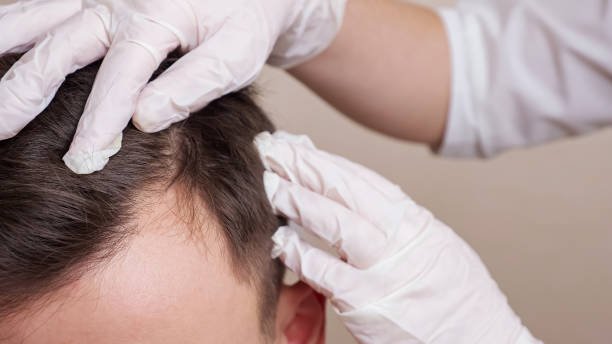Advanced Hair Loss Treatments: The Future of Hair Restoration
🌱 Understanding Hair Loss: Why It Happens
Before exploring advanced treatments, it’s important to understand why hair loss occurs. Common causes include:
Androgenetic Alopecia (Male & Female Pattern Baldness) – Hereditary hair loss caused by sensitivity to dihydrotestosterone (DHT).
Telogen Effluvium – Temporary shedding triggered by stress, illness, or hormonal changes.
Alopecia Areata – An autoimmune condition that attacks hair follicles, causing patchy baldness.
Scalp Disorders – Conditions like psoriasis, seborrheic dermatitis, or infections that affect follicle health.
Advanced treatments often target the underlying cause, aiming not only to regrow hair but also to preserve existing strands and improve scalp health.
🔥 The Most Advanced Hair Loss Treatments Available Today
1️⃣ Platelet-Rich Plasma (PRP) Therapy
How it works:
PRP therapy uses your own blood to stimulate hair growth. A small amount of blood is drawn, spun in a centrifuge to isolate platelets (rich in growth factors), and injected into thinning areas of your scalp.
Why it’s advanced:
The growth factors in PRP are believed to “wake up” dormant hair follicles, increase blood flow, and thicken existing hairs.
Benefits:
✅ Non-surgical
✅ Minimal downtime
✅ Natural, since it uses your own blood
Best for: Early to moderate hair thinning
Results: Visible improvement often appears after 3–6 sessions spaced a month apart, with maintenance sessions every 6–12 months.
2️⃣ Low-Level Laser Therapy (LLLT)
How it works:
This FDA-cleared treatment uses low-level lasers or red light to stimulate cellular activity in the scalp. It increases blood circulation and energizes hair follicles to encourage growth.
Why it’s advanced:
LLLT can be performed at home using laser combs, helmets, or caps—or in-clinic with more powerful devices.
Benefits:
✅ Painless and non-invasive
✅ Suitable for men and women
✅ Can be combined with other therapies like PRP
Best for: Early-stage hair loss or as a maintenance treatment
Results: Noticeable within 4–6 months of regular use.
3️⃣ Microneedling with Growth Factors
How it works:
A dermaroller or microneedling pen creates tiny punctures in the scalp, boosting collagen production and allowing topical growth factors (or PRP) to penetrate deeper.
Why it’s advanced:
Microneedling increases absorption of hair-stimulating serums and triggers wound-healing responses that can reactivate dormant follicles.
Benefits:
✅ Stimulates natural growth pathways
✅ Can be done at home or in-clinic
✅ Pairs well with PRP or minoxidil
Best for: Diffuse thinning or alopecia areata
4️⃣ Stem Cell Therapy
How it works:
Stem cell treatments use harvested cells from your fat tissue (adipose-derived stem cells) or other sources to promote regeneration in the scalp. These stem cells may help create an environment conducive to hair follicle growth.
Why it’s advanced:
Though still experimental in many regions, early studies show promising results for regenerating miniaturized hair follicles.
Benefits:
✅ Cutting-edge regenerative medicine
✅ Targets the root cause of follicle damage
Best for: Patients seeking the latest innovations (usually in clinical trial settings)
5️⃣ Hair Transplant Surgery (FUE & FUT)
How it works:
Hair is harvested from dense areas of your scalp (usually the back or sides) and transplanted to thinning or bald areas.
FUT (Follicular Unit Transplantation): A strip of scalp is removed and dissected into grafts.
FUE (Follicular Unit Extraction): Individual follicles are extracted directly for less scarring.
Why it’s advanced:
Modern techniques like robot-assisted FUE (e.g., ARTAS) deliver natural results with minimal downtime.
Benefits:
✅ Permanent solution
✅ Natural hairline design
✅ High success rate
Best for: Significant hair loss with healthy donor areas
Results: Full results take 12–18 months as transplanted hair grows naturally.
6️⃣ Exosome Therapy
How it works:
Exosomes are tiny vesicles derived from stem cells that carry growth signals. When injected into the scalp, they promote hair regeneration and reduce inflammation.
Why it’s advanced:
This is one of the newest entries in regenerative hair medicine, with early data suggesting faster results than PRP.
Benefits:
✅ Powerful growth factors
✅ May require fewer sessions than PRP
Best for: Patients seeking cutting-edge, non-surgical options
7️⃣ Oral & Topical Medications (Advanced Formulations)
Finasteride & Dutasteride (Oral Anti-androgens): Block DHT, slowing androgenetic hair loss.
Topical Finasteride/Dutasteride: Newer formulations reduce systemic side effects.
Minoxidil (Rogaine): Available in higher concentrations (up to 10%) or compounded with growth factors.
Oral Minoxidil: Low-dose oral minoxidil is now being prescribed off-label for certain patients with promising results.
Why it’s advanced:
Compounded and combination treatments target multiple pathways involved in hair loss.
💡 Combining Treatments for Maximum Effect
Many clinics recommend a multimodal approach, combining:
✔ PRP + LLLT
✔ Microneedling + topical minoxidil
✔ Finasteride + Hair Transplant
This strategy attacks hair loss from different angles for better, faster results.
🕒 When Should You Start Advanced Treatments?
The earlier, the better. Once follicles are completely dormant or scarred over, regrowth becomes much harder. If you’re noticing:
Widening part
Receding hairline
Excessive shedding
…it’s time to consult a hair restoration specialist.


